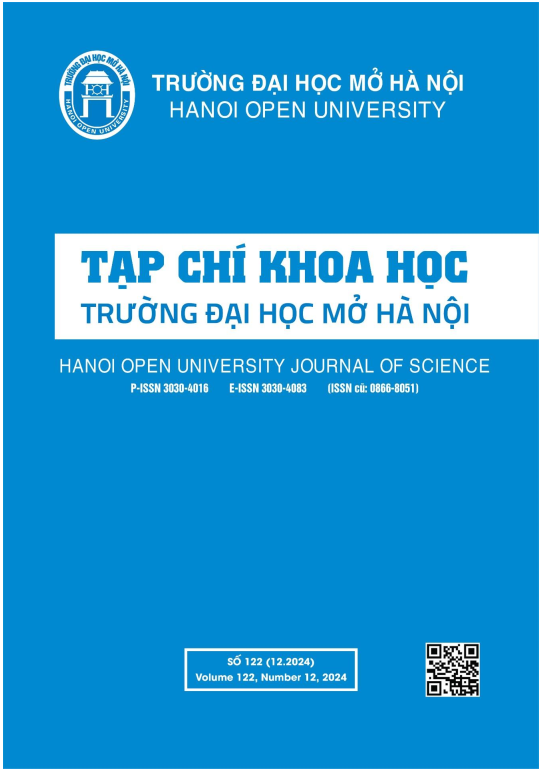THÁI ĐỘ CỦA SINH VIÊN KHI SỬ DỤNG CÔNG NGHỆ THÔNG TIN TRONG VIỆC HỌC TIẾNG ANH
DOI:
https://doi.org/10.59266/houjs.2024.507Keywords:
Tích hợp CNTT trong việc học Tiếng Anh, quan điểm của sinh viên, sinh viên không chuyên ngành Tiếng AnhAbstract
Công nghệ thông tin và truyền thông (CNTT) đã trở thành một công cụ thiết yếu trong lĩnh vực giáo dục, đặc biệt là việc học tiếng Anh. Nhằm mục đích điều tra nhận thức của sinh viên học Tiếng Anh (EFL) đối với việc sử dụng CNTT trong việc học tiếng Anh, 306 sinh viên các khoa chuyên ngành khác nhau của trường đại học Kinh tế- Kỹ Thuật Công nghiệp (UNETI) đã tham gia khảo sát để tiến hành nghiên cứu (NC) định lượng. Công cụ được sử dụng để thu thập dữ liệu là bảng câu hỏi. Phân tích định lượng được sử dụng để phân tích dữ liệu thu được trong NC này. Kết quả cho thấy nhận thức của người trả lời là tích cực ở một số khía cạnh. Nhận thức tích cực và cao được thể hiện ở (1) nhận thức về tính dễ sử dụng, (2) nhận thức về tính hữu ích và (3) thái độ. Kết quả cũng cho thấy rằng phần lớn người được hỏi đều có thiết bị CNTT, trong đó YouTube là hoạt động phổ biến nhất để học tiếng Anh, tiếp theo là Google dịch và mạng xã hội.
References
[1]. Al Arif, T. Z. Z., Sulistiyo, U., Ubaidillah, M. F., Handayani, R., Junining, E., & Yunus, M. (2022). A Look at Technology Use for English Language Learning from a Structural Equation Modeling Perspective. Computer Assisted Language Learning Electronic Journal, 23(2), 18–37.
[2]. Alfadda, H. A., & Mahdi, H. S. (2021). Measuring Students’ Use of Zoom Application in Language Course Based on the Technology Acceptance Model (TAM). Journal of Psycholinguistic Research, 50(4), 883–900. https://doi.org/10.1007/s10936-020-09752- 1.
[3]. Ayele, Z. A. (2022). An Investigation Into the Practices and Challenges of Students’ Use of ICTs in English: Selected Ethiopian Public Universities in Focus. Journal of Language Teaching and Research, 13(4), 707–717.
[4]. Balbay, S., & Kilis, S. (2017). Students’ perceptions of the use of a youtube channel specifically designed for an academic speaking skills course. Eurasian Journal of Applied Linguistics, 3(2), 235–251.
[5]. Boutonglang, D., & Flores, F. (2011). A study on integrating technology to engage 7th graders into an English as a foreign language (EFL) classroom in a rural secondary school, Thailand. International Journal of Arts & Sciences, 4(18), 195–206.
[6]. Caldwell, M. (2020). An Investigation into the Perceptions of Japanese University Educators on the Use of ICT in an EFL Tertiary Setting Review of Literature. 21(2), 1–16.
[7]. Dalton, M. L. (2011). Social Networking and Second Language Acquisition: Exploiting SkypeTM Chat for the Purpose of Investigating Interaction in L2 English Learning [Iowa State University, The USA]. http://lib. dr.iastate.edu/etd/10221/.
[8]. Davis, F. D. (1989). Perceived Usefulness, Perceived Ease of Use, and User Acceptance of Information Technology. MIS Quarterly, 13(3), 319–340. https://doi.org/10.5962/bhl. title.33621.
[9]. Hamidi, H., & Chavoshi, A. (2019). Social, individual, technological and pedagogical factors influencing mobile learning acceptance in higher education: A case from Iran. Telematics and Informatics, 38, 133–165. https:// doi.org/10.1016/j.tele.2018.09.007.
[10]. Howlett, G., & Zainee, W. (2019). 21st century learning skills and autonomy: Students’ perceptions of mobile devices in the Thai EFL context. Teaching English with Technology, 19(1), 72–85.
[11]. Kohnke, L. (2020). Exploring learner perception, experience and motivation of using a mobile app in L2 vocabulary acquisition. International Journal of Computer-Assisted Language Learning and Teaching, 10(1), 15–26. https://doi. org/10.4018/IJCALLT.2020010102.
[12]. Meleisea, E. (2007). The UNESCO ICT in Education Program. United Nations, Education, Scientific, and Cultural Organization. Murray, D. E. (2005). Technologies for second language literacy. Annual Review of Applied Linguistics, 25(1), 188–201.
[13]. Namaziandost, E., Razmi, M. H., Shouket, A. T., & Gilakjani, A. P. (2021). The Impact of Authentic Materials on Reading Comprehension, Motivation, and Anxiety Among Iranian Male EFL Learners. Reading and Writing Quarterly, 0(0), 1–38. https://doi.org/1 0.1080/10573569.2021.1892001.
[14]. Oktalia, D., Ngadiso, & Supriyadi, S. (2018). Integrating ICT in English language learning: Students’ perceptions of a state university in Jambi Province. International Journal of Language Teaching and Education, 2(1), 49–59.
[15]. Rosell-Aguilar, F. (2018). Autonomous language learning through a mobile application: a user evaluation of the busuu app. Computer
[16]. Shevchenko, M. V. (2018). The role of authentic videos in teaching English at technical universities. Advanced Education, 2015(4), 66–70. https://doi. org/10.20535/2410-8286.57306.
[17]. Tran, T. L. N. (2020). Perspectives and attitudes towards self-directed mall and strategies to facilitate learning for different learner groups. Call-Ej, 21(3), 41–59.
[18]. Tsai, Y. R. (2015). Applying the technology acceptance model (TAM) to explore the effects of a course management system (CMS)- assisted efl writing instruction. CALICO Journal, 32(1), 153–171. https://doi. org/10.1558/calico.v32i1.25961.
[19]. Wang, Y. C., & Hsu, L. (2020). Shall we go to the MALL? — Students’ perceptions of a business English learning app. International Journal of Information and Education Technology, 10(2), 110–116. https:// doi.org/10.18178/ijiet.2020.10.2.1348.
[20]. Youssef, A. Ben, Dahmani, M., & Ragni, L. (2022). ICT Use, Digital Skills and Students’ Academic Performance: Exploring the Digital Divide. Information, 13(3), 1–19. https://doi.org/10.3390/info13030129.
